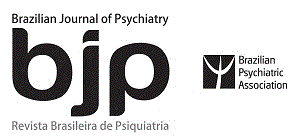Resumo em Português:
OBJETIVO: Descrever as práticas clínicas no tratamento da mania em um hospital brasileiro e compará-las com aquelas descritas e recomendadas nas publicações internacionais. MÉTODOS: Revisão dos prontuários de 425 internações consecutivas (269 pacientes) para episódios maníacos ou mistos (CID-10) em um hospital psiquiátrico privado de Belo Horizonte (MG), de 1996 a 2000. As freqüências de utilização dos diversos medicamentos e de ECT foram comparadas com as descritas em estudos observacionais estrangeiros (X², bicaudado, alfa =0,05). RESULTADOS: As freqüências observadas de uso de cada tratamento foram: lítio (71,5%); carbamazepina (34,8%); valproato (9,4%); antipsicóticos (83,3%); benzodiazepínicos (62,4%); antidepressivos (7,5%) e ECT (33,2%). As divergências encontradas entre as práticas no tratamento da mania observadas neste estudo e aquelas descritas e recomendadas pelas publicações e diretrizes internacionais foram: o uso menos freqüente de valproato e mais freqüente de carbamazepina; o uso de aparelho de ondas sinusoidais para a ECT; e o elevado uso concomitante de ECT com lítio (72,3%), anticonvulsivantes (31,2%) e/ou benzodiazepínicos (46,8%). CONCLUSÕES: Estes achados sugerem a necessidade do desenvolvimento de diretrizes nacionais para o tratamento da mania e uso de ECT e de sua divulgação em programas específicos de educação médica, de forma a uniformizar as condutas fundamentadas na evidência científica disponível.
Resumo em Inglês:
OBJECTIVE: To describe the clinical practices on the treatment of mania in a Brazilian hospital, and to compare them to other international similar reports and practice guidelines. METHODS: Chart revision of 425 consecutive admissions (269 patients) for the treatment of manic or mixed episodes (ICD-10 criteria) in a private psychiatric hospital of Belo Horizonte, Brazil, from 1996 to 2000. The rates of utilization of each antimanic medication and ECT were compared to those reported in similar international observational studies (X², bicaudate, alpha =0.05). RESULTS: The observed frequencies of use of each treatment modality were: lithium (71.5%); carbamazepine (34.8%); valproate (9.4%); antipsychotics (83.3%); benzodiazepines (62.4%); antidepressants (7.5%) and ECT (33.2%). The differences detected between local practice and international guidelines were: lower rate of valproate and higher rate of carbamazepine prescription; the use of sine wave devices for ECT; frequent concomitant use of ECT with lithium (72.3%), benzodiazepines (46.8%) and/or carbamazepine (31.2%). CONCLUSION: These results suggest the need to develop national practice guidelines for the treatment of mania and for the use of ECT, and to promote their propagation through specific medical educational programs, aiming at the standardization of practices based on the available scientific evidence.
